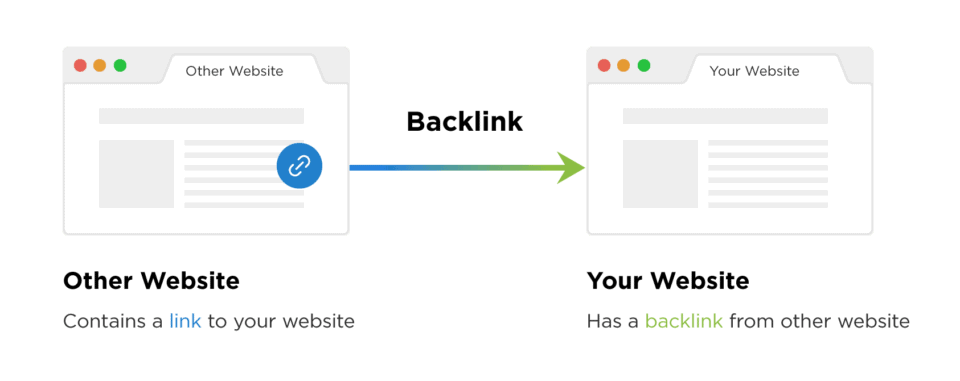Often known as inbound links or incoming links, backlinks are essentially links that connect one website to a page on a different website. They are a critical factor in the organic ranking algorithm of search engines. In simpler terms, when one webpage creates a link to another webpage, it’s referred to as a backlink. These backlinks act as a form of endorsement or vote of confidence, indicating that the webpage providing the backlink deems the linked content as valuable or relevant. The presence of numerous high-quality backlinks can significantly enhance your ranking on search engines such as Google, making them a key element of SEO strategies. However, it’s crucial to remember that not all backlinks are created equal. Some can significantly elevate your ranking, while others can potentially damage it. We’ll delve into these differences later in this article. Therefore, gaining a comprehensive understanding of how backlinks operate and learning how to cultivate quality backlinks is a crucial step in mastering SEO.
Importance of Backlinks in SEO
Backlinks serve as a pivotal element in SEO, significantly impacting a website’s position in search engine results. Their importance can be attributed to several factors.
1. Building Authority and Credibility: When a high-authority website links back to your site, it’s akin to a nod of approval in the eyes of search engines. This endorsement indicates that your content is valuable and trustworthy, thereby enhancing your site’s authority and credibility.
2. Driving Referral Traffic: Backlinks can act as a conduit, channeling visitors from various websites to yours. Visitors who follow these links often have a pre-existing interest in your content, making them potential customers.
3. Enhancing Search Engine Rankings: A website boasting a multitude of quality backlinks stands a better chance of achieving a higher rank in search engine results. Search engines like Google view these backlinks as indicators of quality content, leading to improved visibility in search results.
4. Facilitating Site Indexing: Backlinks assist search engine bots in finding and crawling your site effectively. This is especially beneficial for new websites, as acquiring backlinks is crucial for swift indexing.
5. Increasing Exposure and Visibility: Featuring a backlink on another website can amplify your brand’s visibility and exposure. This not only drives more traffic but also enhances brand awareness.
In summary, backlinks can significantly enhance your website’s visibility, credibility, and search engine ranking. A robust backlink strategy is vital for effective SEO and establishing an online presence.
Differentiating Backlink Types
Not all backlinks are created equal, and understanding their differences is key to crafting an effective SEO strategy. Backlinks can be primarily classified based on two criteria: their SEO value and their origin (whether they are within your site or from external sources). These criteria give rise to two main types of backlinks: Nofollow versus Dofollow, and Internal versus External. Each type plays a distinct role in your SEO efforts and understanding these differences will help you not only increase your backlink count but also ensure you’re cultivating the right kind of backlinks for your business.
Nofollow Versus Dofollow Backlinks
When it comes to backlinks, the distinction between dofollow and nofollow is crucial to understand.
Dofollow Backlinks: These are the standard type of backlinks that pass on SEO value, or link juice, from the linking website to the linked one. They act as a green light for search engines, signaling them to crawl the linked website. This process can enhance the site’s SEO visibility and potentially elevate its ranking. Think of dofollow backlinks as a thumbs-up or a nod of approval, contributing to the credibility of your site.
Nofollow Backlinks: In contrast, nofollow backlinks are a different breed. They do not pass on SEO value from the linking site to the linked one. The ‘nofollow‘ attribute essentially tells search engines to disregard the link when determining rankings. While they may not boost your site’s position in search engine results, they can still drive referral traffic and increase brand visibility.
A well-rounded link profile should ideally include both dofollow and nofollow backlinks. The former boosts your SEO rank through link equity, while the latter diversifies your link profile, making it appear more organic to search engines.
Internal and External Backlinks
Backlinks can also be categorized as internal or external, each playing a unique role in your site’s SEO strategy.
Internal Backlinks: These are links that connect one page of your website to another. For instance, a blog post on your site that links to another related post on the same site is an internal backlink. These links are instrumental in enhancing site navigation, defining your website’s architecture, and distributing page authority and ranking power evenly across your site.
External Backlinks: Alternatively, external backlinks, also known as inbound or incoming links, are links from other websites that lead users to your site. These are particularly beneficial for your SEO. When a reputable, high-authority site links to your website, search engines interpret this as an endorsement of your content. This not only bolsters your website’s credibility but can also enhance your ranking on search result pages.
Both internal and external backlinks are essential for SEO. Internal links improve the interconnectedness of your content and optimize your site structure, while external backlinks enhance your web content’s credibility in the eyes of search engines, thereby boosting your SEO ranking.
Strategies for Building Backlinks
As we venture further into the world of backlinks, let’s explore the key techniques for their creation. These strategies are designed to enhance your website’s quality through relevant, meaningful content and outreach to other platforms and websites. The objective isn’t merely to multiply your backlink numbers but to ensure these backlinks contribute to your SEO ranking and credibility. The primary tactics encompass the creation of backlinks via high-quality content, guest posting, and the utilization of social media platforms. A comprehensive grasp and execution of these strategies can significantly elevate your website’s visibility and foster long-term traffic growth.
Building Backlinks through Quality Content
The cornerstone of backlink generation is high-quality, valuable content. By offering original, informative, and beneficial content, your site becomes a go-to resource that others are inclined to link to.
Unique Research/Data: Embarking on your own research or surveys can produce exclusive insights that others will want to cite. This type of original, data-driven content acts as a magnet for links, enticing others in your industry to reference your findings in their content.
Consistent Blog Posting: Regularly publishing high-quality blog posts keeps your website vibrant and provides ample opportunities for other sites to link back to your articles. By varying the content type, length, and topics, you can appeal to a broader audience and enhance the likelihood of earning links.
Visual Assets: Distinctive, well-crafted infographics, charts, or data visualizations are highly shareable. If these visual assets are unique and convey information in a succinct, clear manner, they can generate a substantial number of backlinks.
Educational and Informative Resources: Resources that educate or inform, such as tutorials, how-to guides, eBooks, or whitepapers, can also attract backlinks. If your content addresses a common question or solves a problem in your niche, it increases the probability of others linking to your content as a resource.
The secret to securing backlinks through quality content lies in its uniqueness, relevance, and value. An SEO strategy that emphasizes content creation not only draws in backlinks but also boosts overall user experience and engagement.
Guest Posting for Backlinks
Guest posting, or guest blogging, is a potent method for accruing backlinks. This approach entails crafting superior content for other blogs or websites, with the reward being a link back to your site.
Identifying Suitable Websites: The first step involves pinpointing websites within your niche that welcome guest posts. These should be credible sites with an audience that would appreciate your expertise.
Producing Tailored, High-Caliber Content: The content you generate for a guest post should be of exceptional quality and specifically designed for the audience of the host site. It should provide value and insights that align with the existing content on their platform.
Author Bio and Backlink Placement: Most host sites will permit you to include a concise author bio, where you can incorporate a link back to your website. Some sites may also allow a contextual link within the post itself, but this should be negotiated in advance.
Cultivating Relationships: Establishing authentic, lasting relationships with other professionals in your field can pave the way for more guest posting opportunities down the line. This not only aids in link building but also broadens your reach and influence within your industry.
Guest posting serves a dual purpose: it helps you secure valuable backlinks and broadens your audience, thereby enhancing your brand visibility. The secret to successful guest posting lies in the relevance and quality of your content.
Earning Backlinks via Social Media
Social media platforms are invaluable resources for earning backlinks. They can be leveraged to promote your content and attract organic backlinks from other users, blogs, or websites.
Promoting Your Content: Consistently posting and promoting your content across various social media platforms can boost visibility. If your followers deem your content valuable, they may link back to it from their own websites or blogs, thus creating backlinks.
Influencer Marketing: Building relationships with influencers in your industry and encouraging them to share your content can result in backlinks. When an influencer shares your content, it reaches a broader audience who might link to it.
Social Bookmarking Platforms: Sites like Reddit, StumbleUpon, or Digg allow users to share and recommend content, which could potentially lead to more backlinks. Be sure to adhere to each platform’s guidelines to avoid penalties.
Engaging with the Community: Active participation in relevant discussions and community groups can help forge relationships and expose your content to new audiences, potentially earning you more backlinks.
While social media links are typically ‘nofollow‘ and don’t carry direct SEO value, they contribute to your link-building efforts by expanding your audience and increasing the likelihood of gaining ‘dofollow’ backlinks through heightened exposure and content visibility.
Monitoring and Maintaining Backlinks
The process of establishing backlinks is only the beginning of your journey. It’s essential to keep a close eye on your website’s backlink profile and maintain it diligently. This ongoing process allows you to evaluate the value your backlinks bring, spot potential issues, and uncover opportunities for future link-building. This involves leveraging SEO tools to analyze your backlinks, discerning and steering clear of detrimental backlinks. By being proactive and vigilant, you can uphold a robust and advantageous backlink foundation that bolsters your SEO efforts and aids in elevating your webpage’s ranking on search engines.
Backlink Monitoring with SEO Tools
Keeping track of your website’s backlink profile is a critical aspect of SEO. A plethora of SEO tools are at your disposal that offer crucial metrics about your backlinks and aid in optimizing your link-building strategies.
Google Search Console: This complimentary tool from Google furnishes data about your website’s performance, including insights about who is linking to your website, the content they link to, and how your site fares in search results.
Ahrefs: Renowned for its extensive data index, Ahrefs offers in-depth reports on your backlinks, encompassing new, lost, and broken backlinks. It also sheds light on your competitors’ backlinks, providing strategic insights.
Moz’s Link Explorer: Moz‘s tool provides exhaustive insights into your website’s link profile, including the quality and relevance of your backlinks.
SEMrush: This platform not only keeps tabs on your backlinks but also enables you to conduct a backlink audit. This aids in identifying potentially harmful backlinks that could be detrimental to your SEO.
Majestic: With its emphasis on backlinks, Majestic offers comprehensive backlink history information, a backlink checker, and a range of other features designed for backlink analysis.
These tools offer invaluable insights that can assist you in maintaining a healthy backlink profile, identifying opportunities for new backlinks, and discarding potentially damaging ones. Regular monitoring and analysis are the cornerstones of successful backlink management for SEO.
Identifying and Avoiding Bad Backlinks
While backlinks can be a powerful tool for boosting your site’s SEO, it’s important to remember that not all backlinks are created equal. In fact, some can even be detrimental to your SEO efforts, particularly if they originate from low-quality or spam-ridden websites.
Spotting Bad Backlinks: So, how can you identify these harmful backlinks? Typically, they originate from websites that are either unrelated or irrelevant to your own. They might also be paid links, part of link exchanges, or stem from websites that have been created solely for SEO purposes. Other red flags include sites with low authority, a poor reputation, or content that has been copied or plagiarized.
Steering Clear of Bad Backlinks: To avoid these damaging backlinks, it’s crucial to keep a close eye on your link profile. By using SEO tools, like the ones we’ve discussed previously, you can monitor your profile and quickly identify any suspicious links.
Dismissing Bad Backlinks: If you do find any bad backlinks, don’t panic. Google’s disavow tool allows you to request that Google disregard these links when assessing your site’s ranking.
Pursuing Healthy Link Building: When it comes to building backlinks, remember that quality always trumps quantity. Aim to secure backlinks from reputable, relevant sites that align with your own.
Upholding Content Quality: Lastly, ensure your content is original, valuable, and relevant. This will not only deter low-quality sites from linking to your content but will also attract more high-quality backlinks.
By staying vigilant and proactive, you can effectively manage your backlinks, safeguarding your site’s reputation and ensuring your SEO efforts continue to yield positive results.







